

LCT
TECHNICAL
The technical, behind-the-scenes work, is a show of its own! In fact, at times it's a three-ring circus! The LCT is a BIG and difficult production! It is so large that SVBC considered termininating it after ten years. But both the church members and much of the Hardin County community said that it was the LCT that made Christmas real to them, and many begged the church not to quit. So instead of ending the yearly production, it has continued to grow larger! Therefore, some details change from year to year, but the general technical information on this page should be close (although you never know what new effect will be presented next year!). Come behind the scenes with us and see a little of what has to be done.
Click on the individual photos for enlargements

AUDIO
 Jim Cottrell at audio board. Click on photo to enlarge (59K).
Jim Cottrell at audio board. Click on photo to enlarge (59K). |
When the church auditorium was remodeled in 1998, a new position was constructed for the audio board, lighting board, and the projection computer. A new, larger audio board was installed, giving 48 inputs, all of which were immediately used! The new board is programmable - a necessity now because of the number of mikes in use and the rapidly-changing scenes.
Approximately 18 wireless mikes are used by the main characters in the drama, 6 wired mikes (most of them boundary mikes) pick up the other characters and the crowds, 6 are used to mike the choir in the tree, 1 to 5 wired mikes are used for soloists and small groups in the tree proper, and one mike is needed for announcements, etc. Inputs are also required for the accompaniment mini disk, the interlude music, and the CD or minidisk player. Both VHF and UHF wireless mikes are used. Many of the drama cast who have speaking parts do not have a wireless mike available to them, so several characters who make only one appearance must share their wireless mike with another member of the cast. This is not as simple as it sounds. Different drama groups dress and wait in different parts of the church, making it difficult to locate the other person. Also, putting on the mike and its transmitter can be a major problem due to the costume, beard, etc.
 Wiring the new audio position, 1999. (52K).
Wiring the new audio position, 1999. (52K). |
There is not enough room for the church orchestra to accompany the choir, so all accompaniment music is "canned" - it is played back from an audio mini disc by the Director (Allen Case), who also has controls for several of the monitor speakers. In addition to the monitor speakers in the overhead cluster, four large monitor speakers are set on the floor facing the Tree near the Director, and two more are set under the framework of the Tree and aimed upward, and two personal monitors set beside the tree for soloists (five sends, 2 speakers per send). Only 5 or 6 mikes are used on the choir because it is difficult to place them properly due to the Tree structure.
 Jim, rewiring the amp rack. (30K).
Jim, rewiring the amp rack. (30K). |
There are 6 power amplifiers which are normally used to drive the several sets of auditorium speakers, monitor speakers, auxiliary speakers, sub-woofers, etc. Two other large amps are used to drive the 4 additional monitor speakers. An additional quadraphonic system, consisting of a digital mini-disk deck, 1000 watt amplifier, and four large speakers, is used for the thunderclap sound effects. This has been one of the most difficult parts of the system. To sound realistic, the thunder from a close lightning strike must be loud! At least four large speakers were blown in the first two years that this system was used! No speakers were blown in 1998, and no new cracks have been found in the plaster! This system now feeds 2 subwoofers, 4 full-range and 1 horn. Total audio power available for the several audio systems, approximately 10,000 watts (almost enough to power the audio system in some of the compact automobiles that we occasionally hear!).
LIGHTING
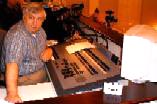 Ron Dowell at programmable lighting board. Click to enlarge (42K).
Ron Dowell at programmable lighting board. Click to enlarge (42K). |
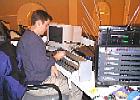 Shawn, at Drama lighting board. Click to enlarge (64K).
Shawn, at Drama lighting board. Click to enlarge (64K). |
The performance of the Living Christmas Tree is also a full light show. A new computerized 96-channel lighting board was installed in 1998, giving the LCT lighting operator (Ron Dowell) the ability to pre-program the board so that sequences, loops, and chases can be started and then will run automatically during a choir number; or, the keys of the board can be "played" as if it were a piano, allowing manual sequences when desired. However, the church owns only about a dozen lights, normally used to light the platform for the local-access cable TV telecast of the Sunday services. So a second, manual lighting board for the drama lights, with a 48-channel controller for the tree proper, several smaller controllers for the overhead lights, and about 60 750-watt and 1000-watt theatrical lights must be rented each year.
 Part of the overhead lights. Click to enlarge (22K).
Part of the overhead lights. Click to enlarge (22K). |
The overhead lighting cage, approximately 20 feet wide by 3 feet deep by 7 feet tall, is permanently attached to the metal framework of the building. It normally holds only the 8-12 lights used for the weekly services, plus the video projector. However, for the LCT, approximately 60 lights (with their controllers) cover the entire front and the two sides of the cage. The Tree can be illuminated by 3 or 4 lights of each of the three colors (red, blue, green), or white. Not only must they be aimed precisely, their barn doors must be adjusted to exactly cover only the Tree. Other lights, singly or in small groups, illuminate various sections of the drama set and isles (where some of the drama also takes place).
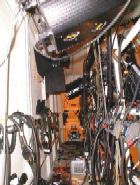 Inside the overhead lighting cage. (74K).
Inside the overhead lighting cage. (74K). |
These must all be pre-programmed so that the scene illumination can be properly changed as the scenes change and the drama moves from one location to another. Two follow-spots in the balcony are used for a number of the moving sequences. Other small lights scattered around, inside of, and behind the stage setting provide effect lighting. The primary circuits feeding this part of the lighting are fused for 200 amps. Normally, only a few lights are on at a time. If all were illuminated at full brilliance simultaneously, it would probably exceed the maximum current available.
 Overall view. Note lighting cage, top. (24K). 1998
Overall view. Note lighting cage, top. (24K). 1998 |
The Tree proper is covered with approximately 3200 small (4-watt C7) colored bulbs, plus about 1000 tiny, clear bulbs. Each level of the tree is strung with four individual color strings - red, blue, green, and mixed. Each color, and also each level, can be controlled separately, allowing for many color, chase, flash, bounce, and other sequences to be programmed. One of the most enjoyable portions for the audience is when the choir does a light, lively number and the lights do a multiple chase sequence in rhythm with the music.
The Tree also is draped with white/silver garland which is interwoven with tiny clear lights, and series of "rope" lights provide a chase sequence horizontally across each level of the Tree. 24 small electronic flash units ("strobes") buried in the tree give a firefly-effect at the end of certain choir numbers.
The large, extremely heavy star was built by some of the men of the church. It is illuminated by a slide projector bulb located behind a rotating color filter wheel. Several thousand tiny fiber optic strands then carry this light to holes hand-drilled in the star. When illuminated, the star slowly changes color over a period of about 30 seconds.
In 1999, several computer-controlled Technobeam lights were added. These, by using a front "heliostat" mirror and several rotating filter wheels, can change direction, color, or pattern almost instantly. They can produce some beautiful effects.
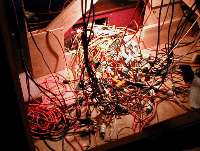 50+ power cables under the tree, before straightening them out (1999). (46K).
50+ power cables under the tree, before straightening them out (1999). (46K). |
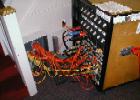 Controller for lights on Tree proper. (60K). (Sign says, "Danger! 100,000 Ohms!") (sic)
Controller for lights on Tree proper. (60K). (Sign says, "Danger! 100,000 Ohms!") (sic) |
Even though the Tree's individual bulbs consume only 5 watts or less apiece, the total current required by the Tree is substantial. If all of the tree lights were illuminated at full brilliance simultaneously, they require approximately 18,000 watts (by actual measurement)! Normally, only one portion or color of the Tree is on at a time, and all except the blue strings are limited to a maximum of 80% brilliance. Even so, after a choir number that also has a light show, the Tree becomes noticeably warmer. In fact, the choir is often hot!! When you consider that over 18,000 watts can be generated by the lights in the Tree itself, 50,000 watts by the overhead lights, plus effect lights, plus the body heat generated by an audience of 1000 and a choir and drama crew of about 200 who are actually participating, it is understandable why the auditorium's air conditioning system must be utilized, even during cold weather!
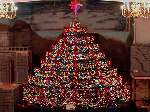 1999 LCT with all lights illuminated. Click to enlarge (60K).
1999 LCT with all lights illuminated. Click to enlarge (60K). |
The light show is one of the most enjoyable features of the LCT production. The worst part of the light show is that choir doesn't get to enjoy it. All they can see are changes in the overhead lights, and the occasional flash of colored bulbs around them. Two of the LCT performances are now televised over the local cable; but, pretty as it may be, there is no way the cameras can capture the true colors of the light show. Obviously, the few photos of the Tree included here can show only a single color or the general location of lights. There is no way these scenes can be adequately displayed - you must see it in person to fully understand what is being said here. Likewise, the several miles of AC power cables, the hundreds of connections, the balancing of the current flow, the climbing through the framework of the Tree to make the connections, can only be hinted at here. It requires a full week of 8- to 12-hour days by 3 to 5 people to hook up the Tree, the overhead lights, etc. After this, the lighting computer must be programmed and tested against the drama script, choir music, and overall program. It is a major job!
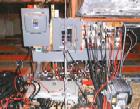 On the attic catwalk. (68K).
On the attic catwalk. (68K). |
Safety is a necessary part of the wiring of the LCT. All circuits have been individually tested for grounds, polarity, maximum current, etc. But it's impossible to avoid occasional incidents - a bulb will be broken, exposing a filament; the insulation on a light string can wear through; or Mr. Murphy can throw in something completely unexpected. The greenery, light strings, and other decorations for each level are all mounted on chicken wire. Each level of chicken wire is individually grounded, and each of the separate light lines/channels has its own breaker, in addition to the fuses normally found in the plugs of each light string. These precautions have proved very helpful.
DRAMA
 Flying angel. (39K). Photo by Mike Byers.
Flying angel. (39K). Photo by Mike Byers. |
The drama takes place on a number of levels, from the floor of the auditorium up across 5 or 6 levels almost to the ceiling, plus the ascension scene which goes out of sight through the ceiling.
While most of the drama requires that the actors negotiate narrow, winding passages and openings behind the set, then climb small sets of steps in darkness, there are three scenes that partially take place in the air.
During two different scenes, an angel flies slowly across the auditorium. A very taut (and doubly-anchored) cable is strung across the auditorium, and a small wheeled carriage is pulled across by ropes. Two wires drop from the carriage (a "Tyrolean traverse") and snap onto shoulder rings on the angel's harness (see the "Angel Page" for photos of the harness). The angel flies about 15 feet above the auditorium floor, but her feet just clear the heads of some of the choir members (and in 1999 did not clear one of the microphones). This angel needs to be a lightweight young lady who does not fear heights. The horizontal traverse cable must be very tight, with little sag, otherwise it would be too difficult to smoothly pull her across. See the "Angel Page" for more photos.
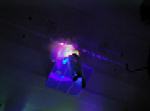 Ascension (from Tree), 1999. (22K).
Ascension (from Tree), 1999. (22K). |
The Ascension Scene has been one of the most difficult to implement properly. It begins in total darkness. Two small cables are dropped in the darkness and clipped onto the shoulder rings of the harness. This normally requires only about 15 seconds, but must be done very carefully. As the choir begins the Hallelujah Chorus, a fog machine on the floor belches out a huge cloud of smoke, and a single follow spot illuminates Jesus as he ascends in front of the Tree. As He nears the ceiling, before going behind the speaker cage, an overhead fog machine blows a large cloud down from above. The hole in the ceiling is barely wide enough for the actor's shoulders, and the lift is a belt-driven winch on a Rube Goldberg frame, which must wind the two cables equally so that one shoulder is not pulled faster than the other.
 Ascension. (12K). Photo by Mike Byers.
Ascension. (12K). Photo by Mike Byers. |
ASCENSION STORIES
This usually goes OK. However, during one performance in 1994, one of the cables hit the Tree, causing the positions of the two cable ends to be reversed. In the darkness no one was aware that the right cable was attached to the left shoulder and the left cable to the right shoulder until the lift had already started. By then the spotlight was on and it was too late to change anything! The cast on the ground held the now-ascending actor as long as they could reach him. When he was beyond their grasp, he began a very slow rotation! John spread his arms wide to slow it down as much as possible; but by the time he was half way to the ceiling he had turned around and was facing the choir in the Tree! The choir, meanwhile, was trying to sing the difficult middle part of the Hallelujah Chorus, which is made additionally difficult by not being able to see Allen's directing because of the clouds of tiny oil droplets ("smoke") from the fog machines! Facing the choir in the tree and with his back now to the audience, John proceeded to blow a quick kiss to the choir!
 Ascension, available light. (11K).
Ascension, available light. (11K). |
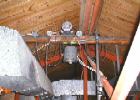 Ascension lift mechanism. (68K).
Ascension lift mechanism. (68K). |
The choir almost lost it at this point, but managed to keep singing. Meanwhile, John had continued his rotation, and how had started back the other direction! The show must go on, so John simply used this opportunity to again bless the audience. Those there for the first time though this was great, and didn't even realize that anything was wrong. Those who see the production every year, however, were watching in fascination, wondering how he would get through the hole in the ceiling. But, as he approached, the stage hands above him simply reached down, grasped the two cables to stabilize him, and brought John on up with no more difficulties. This was prior to telecasting the LCT live, but Lora Ennis was videotaping with a semi-professional (but single camera) setup. The "Rotating Rabbi Ascension Scene" quickly became a favorite part of the LCT history! Ah, yes, Mr. Murphy must love the LCT!
"Let's make some memories," the song says. 1999 must have been Murphy's favorite year. During one performance, one of the lift cables dropped properly - but the other cable went on the other side of a horizontal cable near the ceiling. Needless to say, when the ascension-actor for that year Lloyd (president of a local bank) reached the horizontal cable, something had to happen! But by this time, those running the lift mechanism realized the problem and returned him to the ground - knocking off his wig in the process. There were no injuries, and it was reported that this year's production was even more Biblical than ever before. We not only presented His first advent, we also ended the production with the Second Coming!
(Some other short stories, including a photo of the 1999 Chariot Crash, can be found on the "Scenes" Page).
 Ann and Allen Case, through remains of fog. (24K).
Ann and Allen Case, through remains of fog. (24K). |
COMMUNICATIONS
During the Dress Rehearsal there's need for communications around the building. The drama cast is spread all over the church; and during this rehearsal, many don't know when they are to enter or what happens next. Communications needs are less during the actual performances, but still are necessary to find a straying shepherd, call for the stage crew to do an emergency repair, or to take care of the latest problem that Mr. Murphy has thrown our way. Radios are also critical for cueing several of the special effects.
A 6-station wired intercom connects the PA, broadcast audio, and television control positions, the music director's location, and the church office. A long extension cable allows one unit to be carried into the Tree with the choir. As the PA operator cannot hear the monitor speakers, this enables the audio operator to set the monitor levels during the Dress Rehearsal. It was also planned that this wired intercom would be a primary system during a medical or other emergencies, but it has not worked well for this.
The church's business band walkie-talkies on 469.900 and 464.900 (simplex) are used, and beginning in 1998, a number of FRS walkie talkies were also pressed into service for the LCT. There is occasional interference, but fewer communications are needed after the Dress Rehearsal. These small walkie-talkies have so far done reasonably well, although it is expected that interference will become too great very soon. Two FRS frequencies are required - one for the drama crew while an additional FRS channel is used by the parking lot attendants. Other frequencies used are 145.520, and a frequency in the 76 MHz range for the hearing-impaired transmitter (small receivers are available in the front lobby).
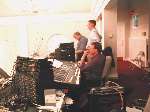 L-R; Ron Dowell, Shawn Rich, Jim Cottrell. Click to enlarge (35K)
L-R; Ron Dowell, Shawn Rich, Jim Cottrell. Click to enlarge (35K) |
OTHER
There are several other effects that take place during the program. These may be dramatic and somewhat startling, but are mechanically very simple. Since they are more effective if the audience is surprised, we'll let you discover these on your own!
Photographs on these pages by Mike Byers, Shelby Ennis, and Lora Ennis.
These pages are not authorized by, nor sponsored by Severns Valley Baptist Church or its paid staff, but are an independent undertaking for the enjoyment of those interested in the LCT and what happens behind the scenes to create the production.
![]()



















